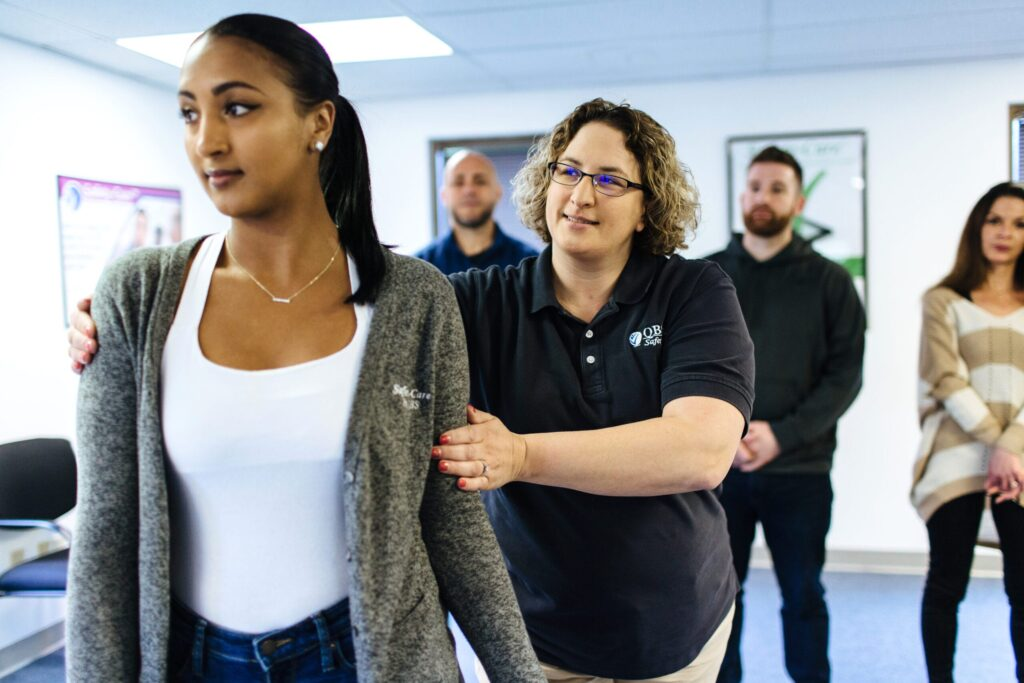Colorado – Standards for Hospitals and Health Facilities, General Licensure
In January of 2020, the State of Colorado issued new regulations regarding the use of restraint and seclusion in hospital and health care facilities. Below is a summary of these regulations. Additionally, there are descriptions of how Safety-Care can be used to best meet the needs of staff regarding these new regulations.

.png?width=88&height=95&name=Group%20137%20(5).png)


How to Implement Safety-Care?
1. Register for a Safety-Care Trainer class or call us to request a closed session for your organization. We regularly conduct classes in all 50 states and Canada.
2. Complete your class to become a certified Safety-Care Trainer for your organization. We bring you to fluency using an errorless teaching methodology.
3. You train and certify your staff in Safety-Care’s effective techniques.
4. Our Master Trainers are available by phone, email, or video to help your organization with any questions or concerns while using or implementing Safety-Care.

Legal Requirements
|
Summary: Effective: January 14, 2020 Last Updated: December, 2024 In January of 2020, the State of Colorado issued new regulations regarding the use of restraint and seclusion in hospital and health care facilities. Below is a summary of these regulations. Additionally, there are descriptions of how Safety-Care can be used to best meet the needs of staff regarding these new regulations. How Safety-Care aligns: Numerous health organizations throughout the United States and Canada rely upon QBS and our Safety-Care training to provide their staff members with the training they need to help maintain a safe and healthy environment. Safety-Care provides a comprehensive, supportive approach to incident prevention, de-escalation, and management. Your Staff will learn practical strategies for helping students that use evidence-based practices consistent with PBIS (Positive Behavior Interventions and Supports) and ABA (Applied Behavior Analysis). |
|
Basis for Use of Restraint or Seclusion A facility may only use restraint or seclusion: (A) In cases of emergency, as defined at section 26- 20-102(3), C.R.S., to be a serious, probable, imminent threat of bodily harm to self or others where there is the present ability to effect such bodily harm; and (1) After the failure of less restrictive alternatives; or B) A facility or agency that uses restraint or seclusion pursuant to the provisions of (A), above, shall use such restraint or seclusion: (1) Only for the purpose of preventing the continuation or renewal of an emergency; |
|
Restraint and seclusion must never be used: (A) As a punishment or disciplinary sanction, (1) The restraint or seclusion is ordered by the court, or How Safety-Care aligns: Safety-Care is uniquely designed to provide trainees with the skills to assess potential crises, how de-escalate these situations, and how to respond if the situation is elevated. Our trainings are trauma-informed and focus on modifying behavior to prevent dangerous outcomes. Safety-Care can be taught to all levels of personnel, from administration down to volunteers. Additionally, our core trainings can be supplemented with unique add-on trainings focused on specific needs and professions. Safety-Care uses a Train the Trainer model allowing each district to quickly develop their own core of trainers qualified in the most current behavioral interventions and de-escalation strategies. Our Master Trainers can have up to ten (10) staff ready to train in as little as three days. Safety-Care is geared towards ensuring that all trainees are familiar with a single response system and can respond in-kind to numerous situations regardless of the professional setting. |
|
Duties Relating to Use of Restraint or Seclusion (B) No physical or mechanical restraint of a client shall place excess pressure on the chest or back of that client or inhibit or impede the client’s ability to breathe; A client in physical restraint shall be released from such restraint within fifteen (15) minutes after the initiation of physical restraint, except when precluded for safety reasons. |
|
Staff Training Concerning the Use of Restraint and Seclusion (A) All facilities and agencies shall ensure that staff are trained to explain, where possible, the use of restraint or seclusion to the client who is to be restrained or secluded and to the client’s designated representative, if appropriate. How Safety-Care aligns: Safety-Care initially focuses on incident minimalization, in an effort to support positive behaviors and reduce risks. Physical safety training is focused on staff’s situational awareness and physical protection within their work environments. It includes safety techniques aimed at preventing common staff injuries and includes relevant role-plays. Finally, physical management techniques are taught. These techniques focus on a least-to-most restrictive process, emphasizing natural positioning, minimal intrusiveness, and the safety of all involved parties. |
|
Documentation Requirements Related to the Use of Restraint and Seclusion Each facility shall ensure that an appropriate notation of the use of restraint or seclusion is documented in the record of the client who was restrained or secluded. Each facility shall document the following in the client record: (A) Type of restraint and length of time in the restraint or seclusion; |
|
Review Process: Each facility or agency that Utilizes restraint or seclusion under this Part 8 shall ensure that a review process is established for the appropriate use of the restraint or seclusion. |
|
Facility or Agency Policies Regarding the Use of Restraint and Seclusion A facility or agency that uses restraint or seclusion shall develop and implement policies and procedures consistent with the requirements of this Part 8. (A) A facility’s or agency’s policies and procedures regarding the use of restraint and seclusion may be more stringent than this Part 8, but shall not be less stringent. A facility or agency that does not use restraint or seclusion shall include a written statement in its policies and procedures to that effect. How Safety-Care aligns: Safety-Care requires that all trainees comply with local laws and regulations regarding reporting and debriefing. Additionally, Safety-Care’s Trainer Connect program can be used to assist in documenting interactions where Safety-Care has been utilized. |
Why Safety-Care?
Benefits & Differentiators
In addition to Safety-Care being highly cost-effective, you get:

Skills to effectively prevent, minimize, & manage behavioral challenges with dignity, safety, & the possibility of change

Decreases in staff and patient injuries and reduction in restraint & seclusion time

Instructional procedures based on decades of evidence-based research & compatible with ABA, PBIS & reinforcement-based environments

Customizable program for your setting, staff & clientele, with a strong focus on preventative via non-intrusive, replacement behaviors

Extremely rigorous standards grounded in errorless teaching methodology

Small, intimate class sizes backed by unlimited support & resources
How Is Safety-Care So Effective?
A Genuine Focus on Implementing & Managing Positive Behavioral Skills
Proactive, environmental management recommendations
Understanding of evocative effects of staff behavior
In-depth analysis of antecedents and proactive antecedent interventions
Evidence-based reinforcement procedures
Required competency in de-escalation skills
Humane, non-invasive touch and QBS Check™ strategies
Evidence-based teaching procedures
Applicable to a wide array of settings, conditions & challenging behavior





